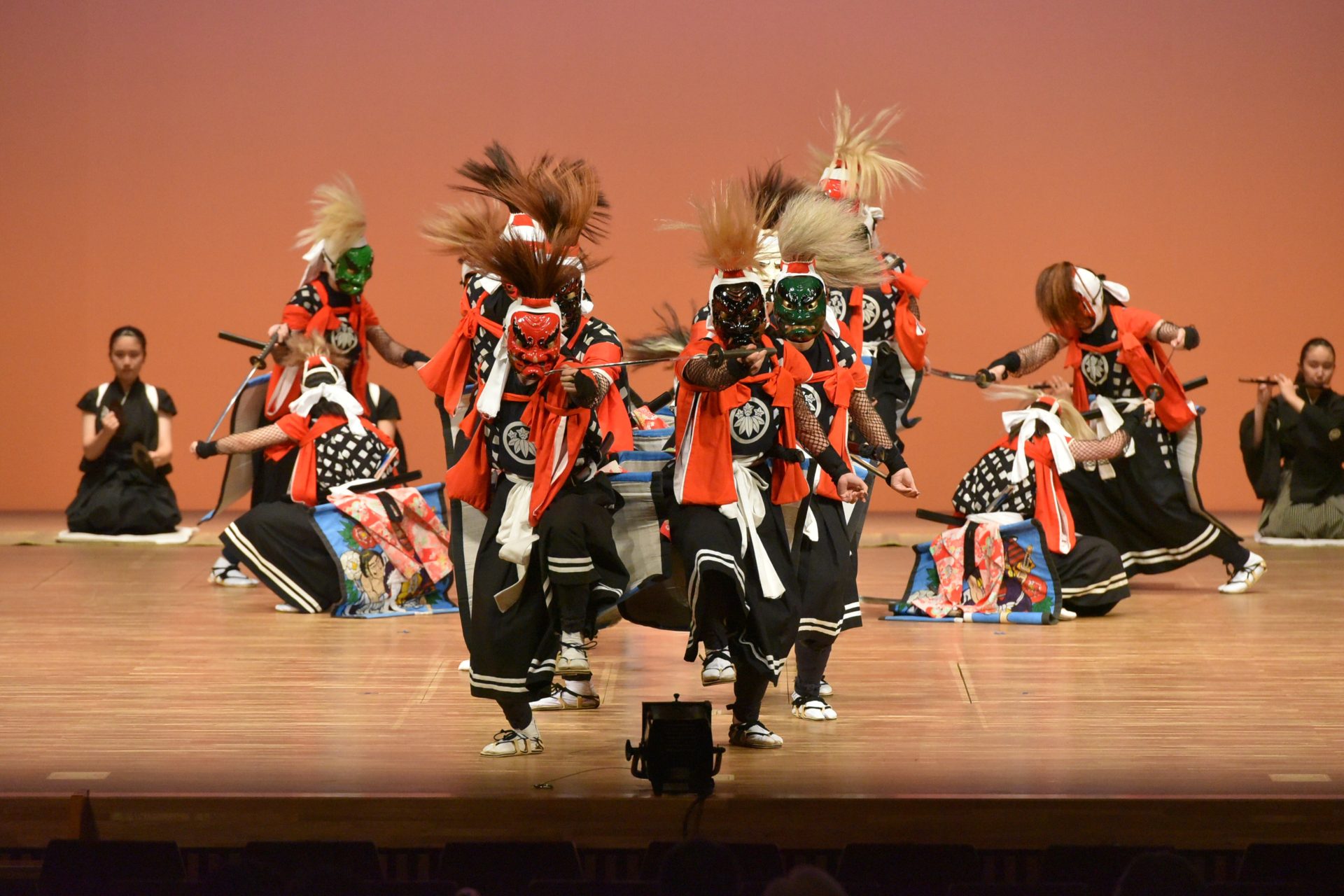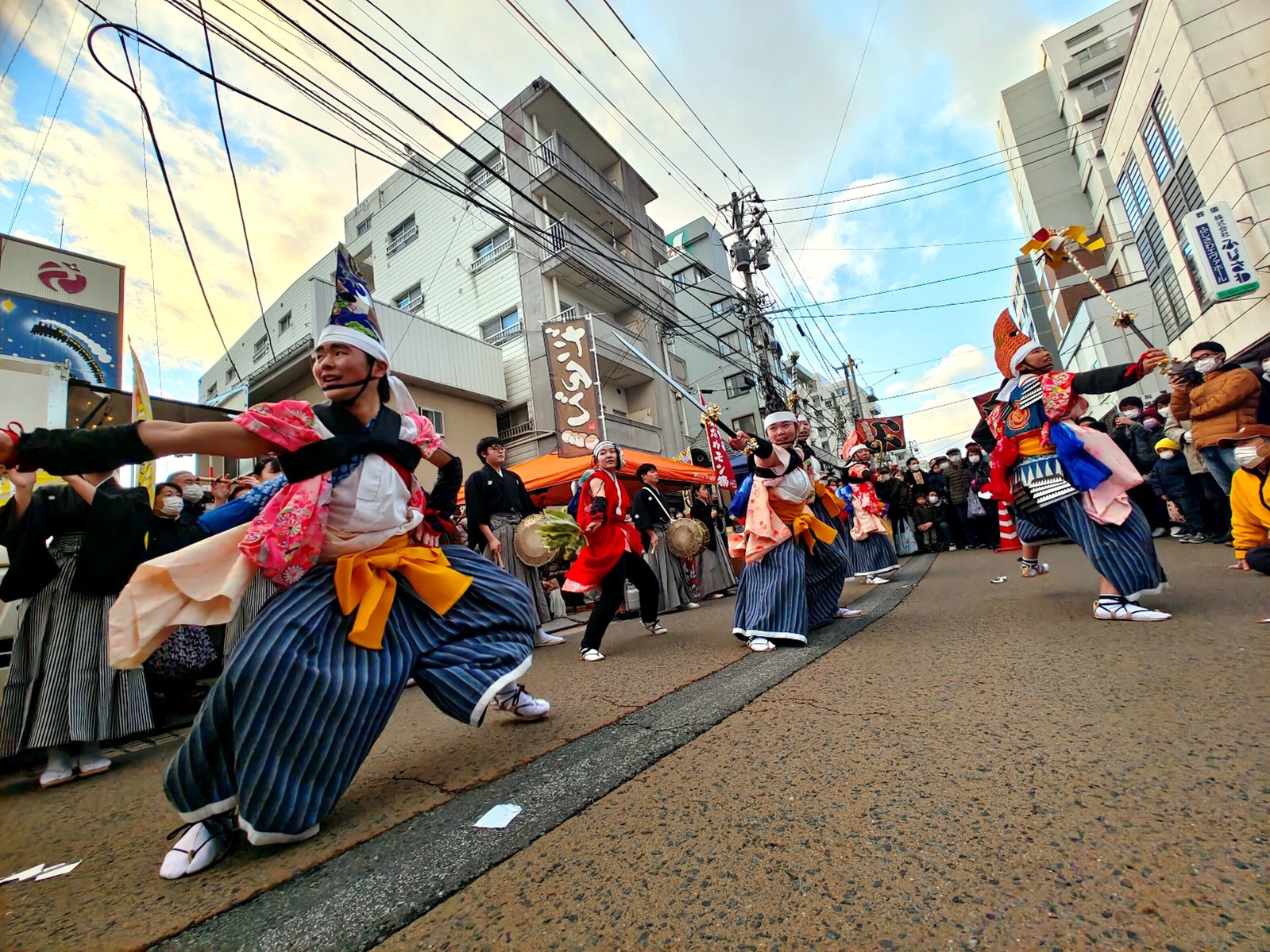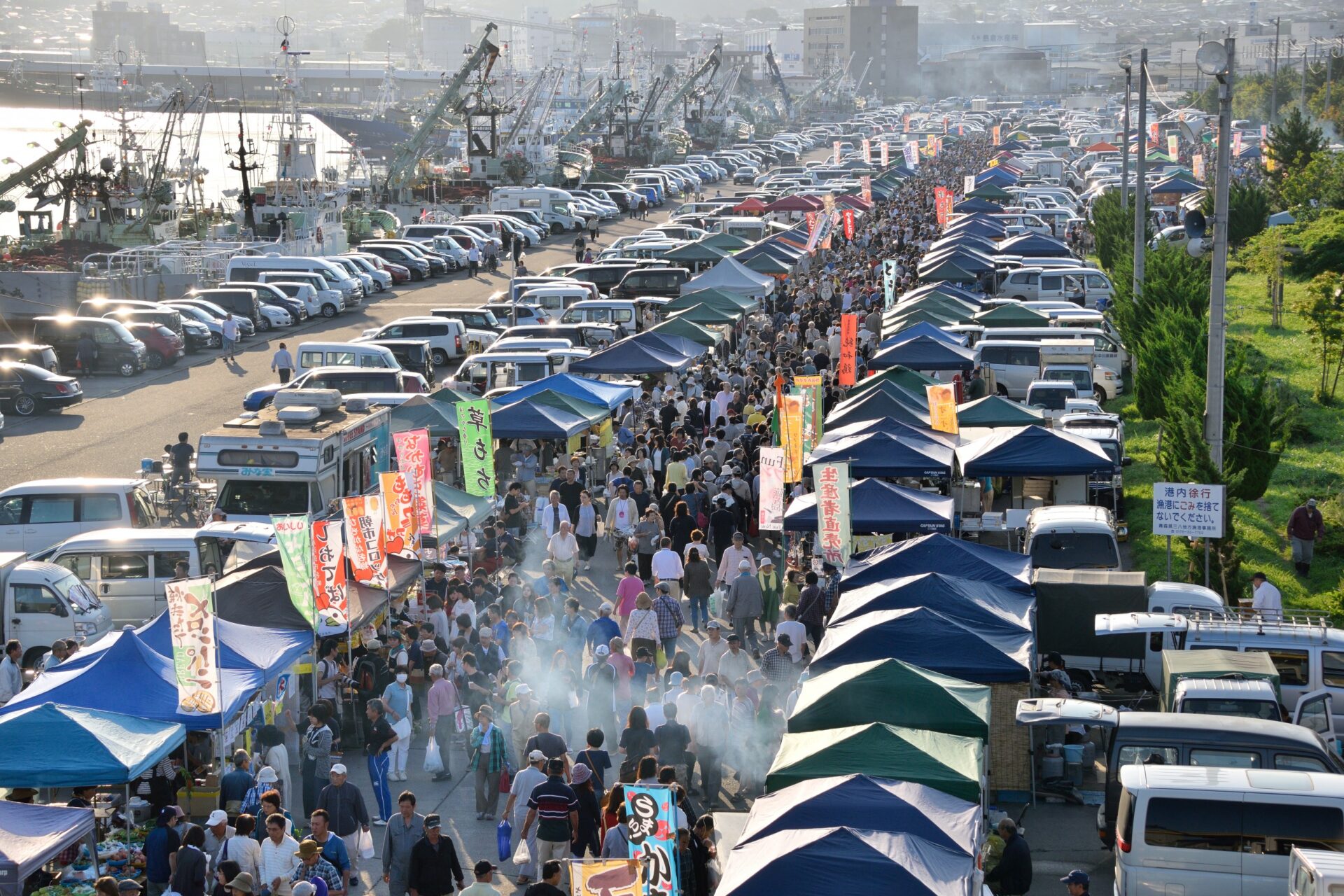EVENT
Suggested Route | A Trip to Meet the Young Geinoh Practitioners 3Days and 2Nights Sep.9th(Fri)-11th(Sun)
- 2022
- suggested-route
Route: From Tokyo to Hachinohe to Hirono
One of the two major events of this year’s Sanriku International Arts Festival will be held in Hirono Town, Iwate Prefecture, namery, Geinoh Meeting along with Sanriku Future Geinoh Festival, where young geinoh practitioners gather and perform. This is a 3-day, 2-night suggested route in which you can watch and participate in them. The 1st day is to explore the city of Hachinohe and enjoy its local food, nature, and history. The 2nd and 3rd day will focus on events for experience, communication and appreciation, meeting with the young performers. Please enjoy, against the backdrop of the scenery of the Sanriku coastal area, which is also a certified Geopark.
Please note that the suggested routes introduced here are not organized tours. The routes are designed to assist travelers in planning their trip and fully enjoy the Sanriku area.
Notices on Accommodation and Transportation
* Due to the Misawa Air Base Air Festival that is held in Misawa City, Aomori Prefecture on Sturday, Sep. 10th, reservations for hotels will be hard to make in Hachinohe City, Aomori Prefecture and Hirono Town, Iwate Prefecture. Hence, we recommend planning ahead and booking your accommodation in advance.
Though public transportation is the primary mode of transportation,we also recommend considering using taxi or car according to the situation.
* As part of COVID-19 countermeasures, there may be changes to the operating hours of public transport, facilities and stores. Please check for any updates in advance.
Countermeasures against COVID-19
* To prevent the spread of COVID-19, please take note and follow the countermeasures indicated at each event, facility, and store.
A Trip to Meet the Young Geinoh Practitioners of Sanriku Future Geinoh Festival & Geinoh Meeting Trip 3 Days and 2 Nights
Route: Tokyo to Hachinohe to Hirono
Sep .9th (Fri)-11th(Sun),2022
| Day 1 Sep. 8th (Fri),2022 |
Hachinohe, a Town Where You Can Enjoy Sanriku’s Food, Nature, and History
| Itinerary | remark | |
|---|---|---|
| 09:08 | From Tokyo Sta. to Hachinohe Sta.(Arr. 12:01) | Tohoku Shinkansen ‘Hayabusa 11’ |
| 12:35 | From Hachinohe Sta. to Hasshoku Center(Arr.12:47) | East Exit Bus Stop No. 8 Dedicated bus for Hasshoku Center |
| 13:00 | Hasshoku Center | |
| 14:25 | From Hasshoku Center.to Central Town (Muikamachi) (Arr.14:45) | Kuriya Stadium East Exit Hachinohe Central City Terminal Bus Stop No. 5 |
| 15:00 | Hotel Check-in | |
| Central Town | Explore on foot | |
| Hachinohe Art Museum | Explore on foot | |
| Hachinohe Book Center | Explore on foot | |
| Hachinohe Portal Museum “Hacchi” / Hachinohe Machinaka Plaza “Machiniwa” | Explore on foot | |
| Hachinohe Yokocho | Explore on foot |
| Day 2 Sep. 9th (Sat),2022 |
Join us to talk and dance with the young geinoh practitioners!
| Itinerary | remark | |
|---|---|---|
| 09:37 | From Hachinohe Sta. to Same Sta.(Arr.09:50) | JR Hachinohe Line Kuji direction |
| 09:58 | From Same Sta.to Kabushima Island Seaside Park(Arr.10:00) | Umineko-go Single Coin Bus Tanesashi Coast Leisure Bus |
| 10:00 | Kabushima Shrine | Explore on foot |
| Hachinohe City Marine Science Museum “Marient” | Explore on foot | |
| 11:14 | From Marine Science Museum Bus Stop to Tanesashi Kaigan Information Center (Arr.11:37) | Umineko-go Single Coin Bus Tanesashi Coast Leisure Bus |
| 12:20 | Trekking program that starts and ends at the Tanesashi Kaigan | *Reservations are required *This program is only available on September 10, 2022. For more information, please contact the Tanesashi Kaigan Information Center. |
| 15:01 | From Tanesashi Kaigan Sta. to Taneichi Sta.(Arr.15:23) | JR Hachinohe Line Kuji direction |
| 15:40 | Dancing Through Hirono:The Geinoh Meeting Leaflet | 16:00-18:00 |
| 19:02 | From Taneichi Sta.to Honhachinohe Sta.(Arr.19:52) | JR Hachinohe Line Hachinohe direction |
| 20:10 | Hachinohe Yokocho | Explore on foot |
| Day 3 Sep.10th(Sun),2022 |
Witness the Bursting Energy from the Young Performers!
| Itinerary | remark | |
|---|---|---|
| 06:13 or 07:16 | From Honhachinohe Sta. to Mutsuminato Sta.(Arr.06:19 or 07:23) | JR Hachinohe Line Kuji direction |
| 07:40 | Tatehana Wharf Morning Market | Opening Hours: Every Sunday from sunrise to approx. 9:00 a.m. |
| 09:44 | From Mutsuminato Sta. to Taneichi Sta.(Arr.10:24) | JR Hachinohe Line Kuji direction |
| 10:40 | Hirono Suisankaikan UNIQUE | Explore on foot |
| 11:30 | Hamanasu-tei Main Restaurant | Explore on foot |
| 12:30 | Dancing Through Hirono: The Sanriku Future Geinoh Festival | 13:00〜15:45 |
| 17:44 | From Taneichi Sta. to Hachinohe Sta.(Arr.18:44) | JR Hachinohe Line Hachinohe direction |
| 19:06 or 20:12 | From Hachinohe Sta. to Tokyo Sta.(Arr.22:04 or 23:04) | Tohoku Shinkansen ‘Hayabusa 46’ |
Day 1
Sep. 8th (Fri),2022
Hachinohe, a Town Where You Can Enjoy Sanriku’s Food, Nature, and History
| Itinerary | remark | |
|---|---|---|
| 09:08 | From Tokyo Sta. to Hachinohe Sta.(Arr. 12:01) | Tohoku Shinkansen ‘Hayabusa 11’ |
| 12:35 | From Hachinohe Sta. to Hasshoku Center(Arr.12:47) | East Exit Bus Stop No. 8 Dedicated bus for Hasshoku Center |
| 13:00 | Hasshoku Center | |
| 14:25 | From Hasshoku Center. to Central Town (Muikamachi)(Arr.14:45) | Kuriya Stadium East Exit Hachinohe Central City Terminal Bus Stop No. 5 |
| 15:00 | Hotel Check-in | |
| Central Town | Explore on foot | |
| Hachinohe Art Museum | Explore on foot | |
| Hachinohe Book Center | Explore on foot | |
| Hachinohe Portal Museum “Hacchi” / Hachinohe Machinaka Plaza “Machiniwa” | Explore on foot | |
| Hachinohe Yokocho | Explore on foot |
Tokyo Sta.

Tohoku Shinkansen ‘Hayabusa 11’
Dep. 09:08
Arr. 12:01
Travel time| 2hrs 53min
Hachinohe Sta.

East Exit Bus Stop No. 8
Dedicated bus for Hasshoku Center
Dep. 12:35
Arr. 12:47
Travel time| 12min
13:00 Hasshoku Center
Hachinohe’s Foods, Entertainments, and Activities are All Here!
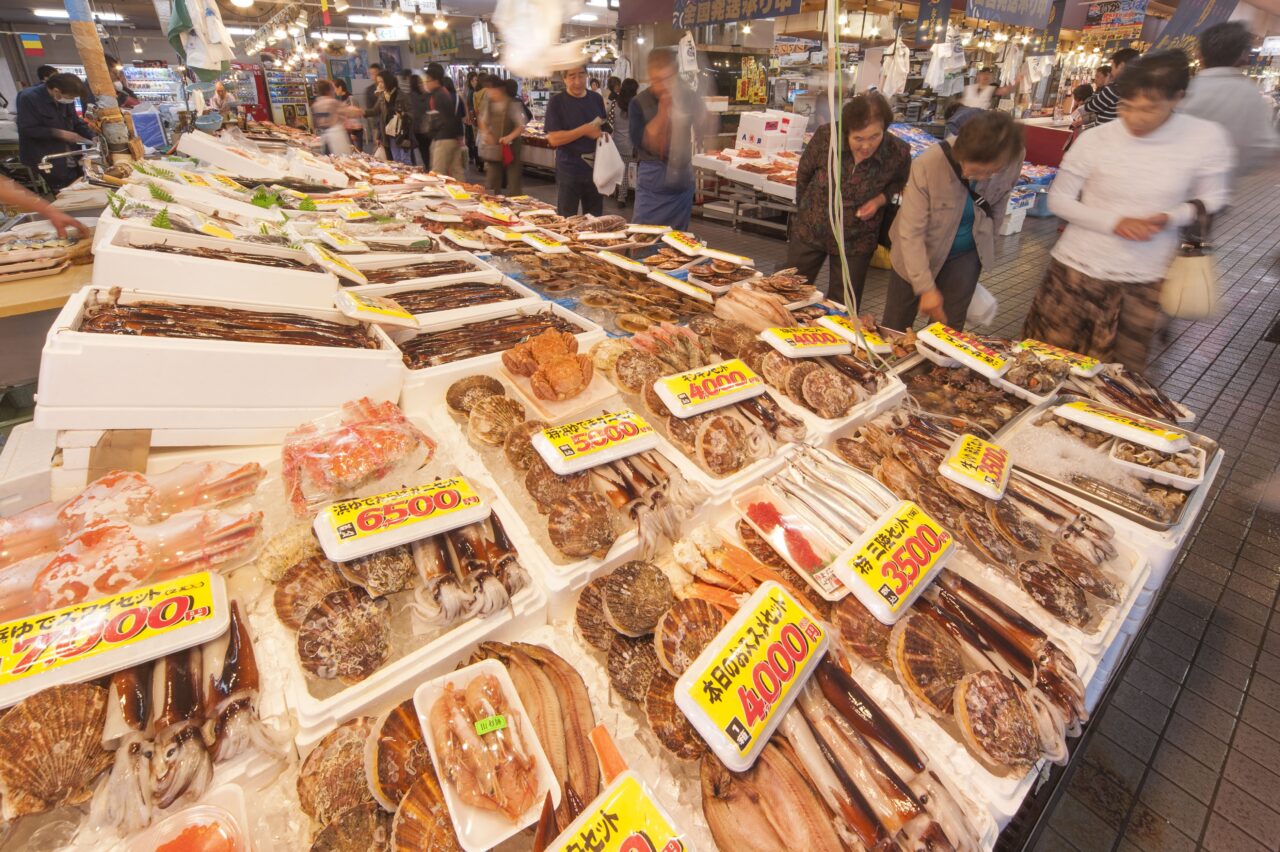
▲There is not only fresh seafood, but also takoyaki, coffee, fruit sandwiches, and much more.
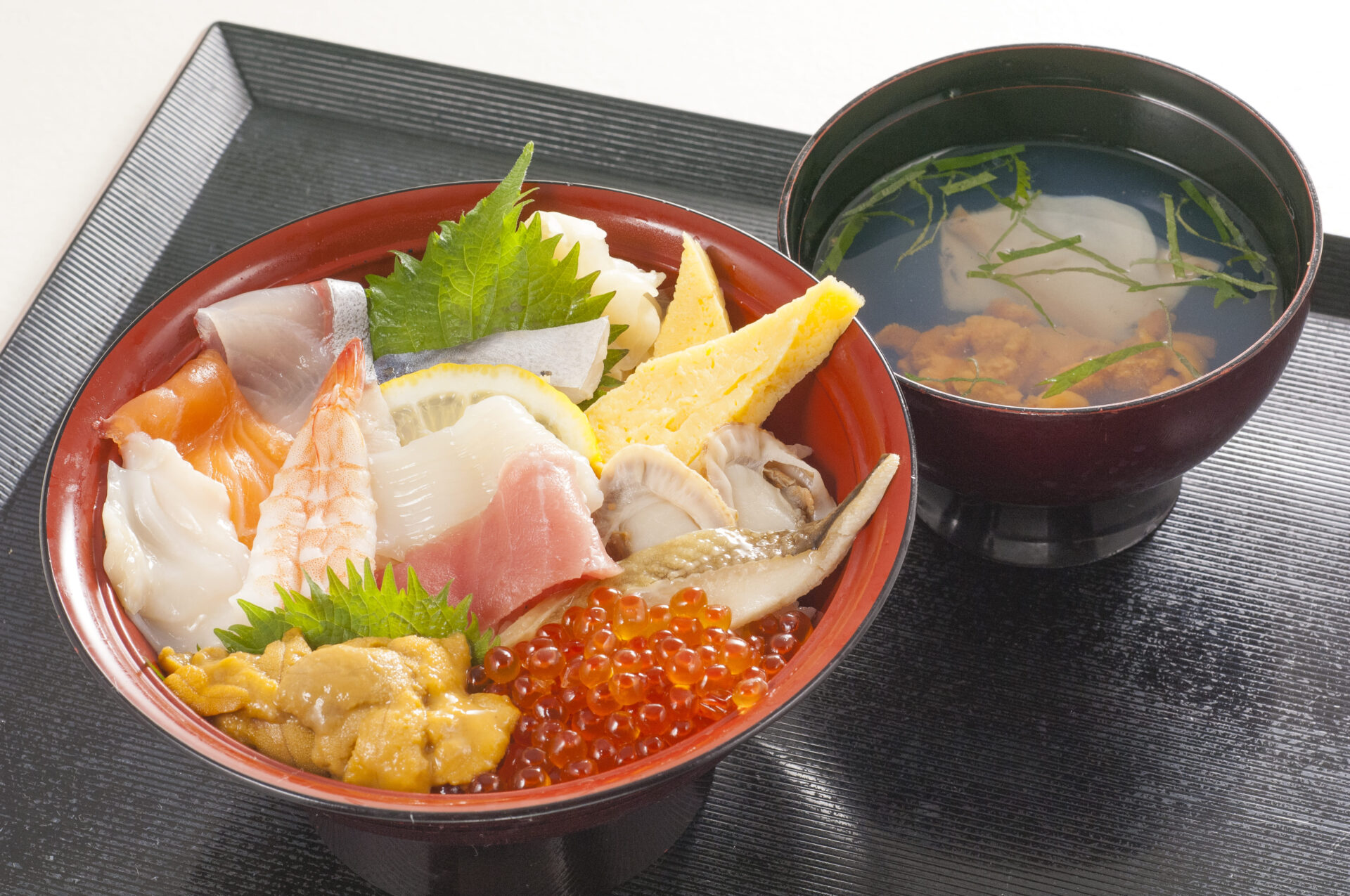
▲ Ichiba-tei
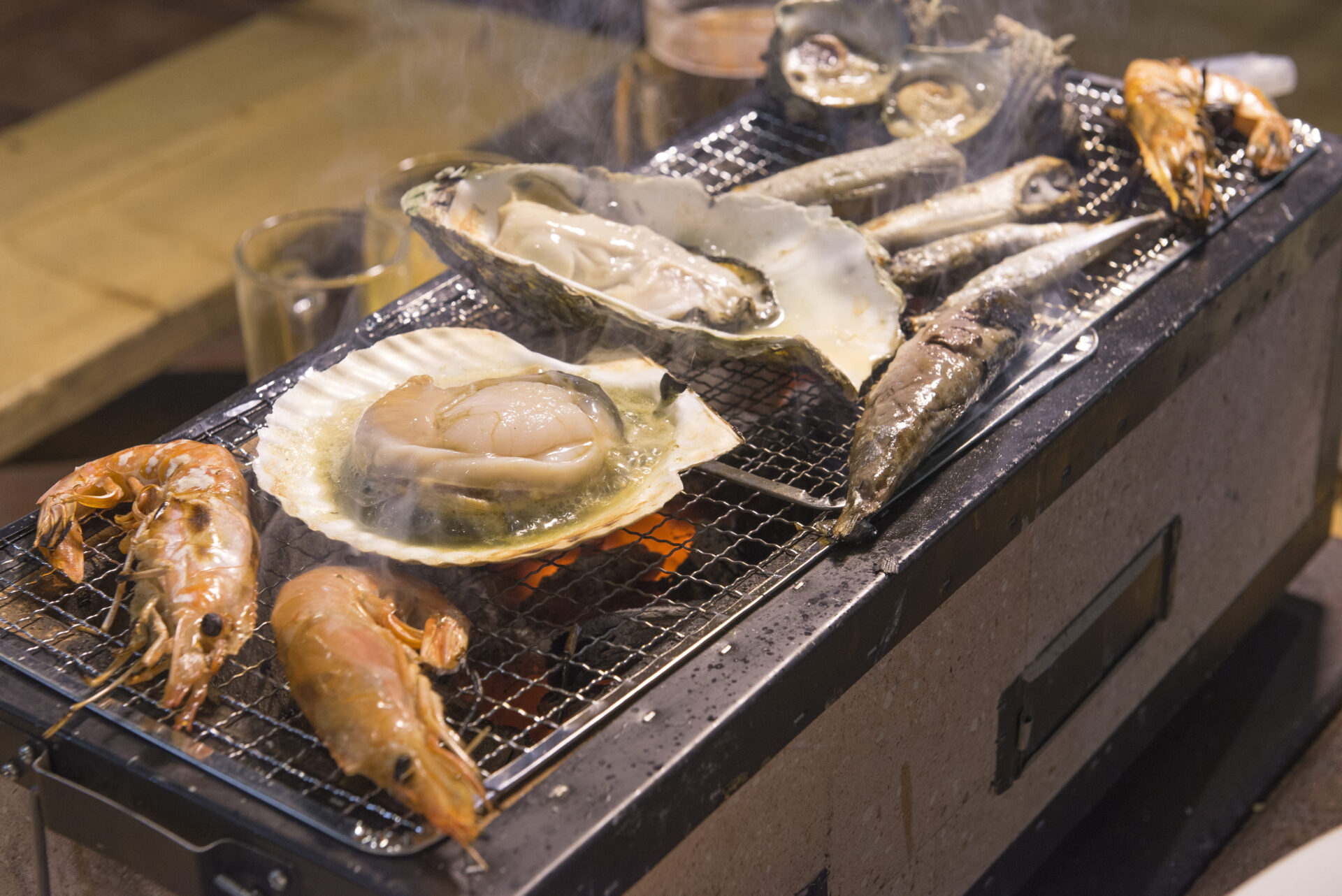
▲Any foods you purchase at the center’s Shichirin Village can be grilled for you to taste!
Hachinohe’s Giant Market Where You Can Devour Foods from Hachinohe to the Fullest!
Freshly caught seafood, dried delicacies, souvenirs, and other Hachinohe specialties can all be found here!
The seasonal produce on display is a powerful sight to behold. There are also great facilities, including the Shichirin Village where you can taste your purchases on the spot. The nokke-don (bowl of rice topped with a variety of ingredients) is very popular, and visitors can freely add their own favorite ingredients to the bowl! There are also many events including free live performances, comedy performances, tuna fileting shows, and “Hasshoku Cooking Dojo” where you can learn professional techniques!
For access to the market, take the Hasshoku 100-yen bus (JR Hachinohe Station loop bus) and the Hasshoku 200-yen or less bus (Hachinohe central area loop bus).
Hasshoku Center
22-2 Aza-Kansai, Kawaragi, Hachinohe-shi, Aomori
Opening Hours: 9:00–18:00 Market Building
9:00–18:00 Aji Yokocho (closed on Wednesdays)
9:00–21:00 Food & Beverage Building – Kuriya Stadium (closed on New Year’s Day)
Phone|+81 (0)178-28-9311
FAX|+81 (0)178-28-9312

East Exit Bus Stop No. 8
Dedicated bus for Hasshoku Center
Dep. 14:25
Arr. 14:45
Kuriya Stadium East Exit
Hachinohe Central City Terminal Bus Stop No. 5
Travel time|20min
Central Town
Hachinohe City’s central area is a wonderful mix of new and old, with many attractive places within walking distance. Try taking a stroll around the town.

Explore on foot
15:00 Hotel Check-in
Hachinohe Art Museum
Sowing the Seeds to Cultivate Community, and Create a Vision for Hachinohe in the 22nd Century.
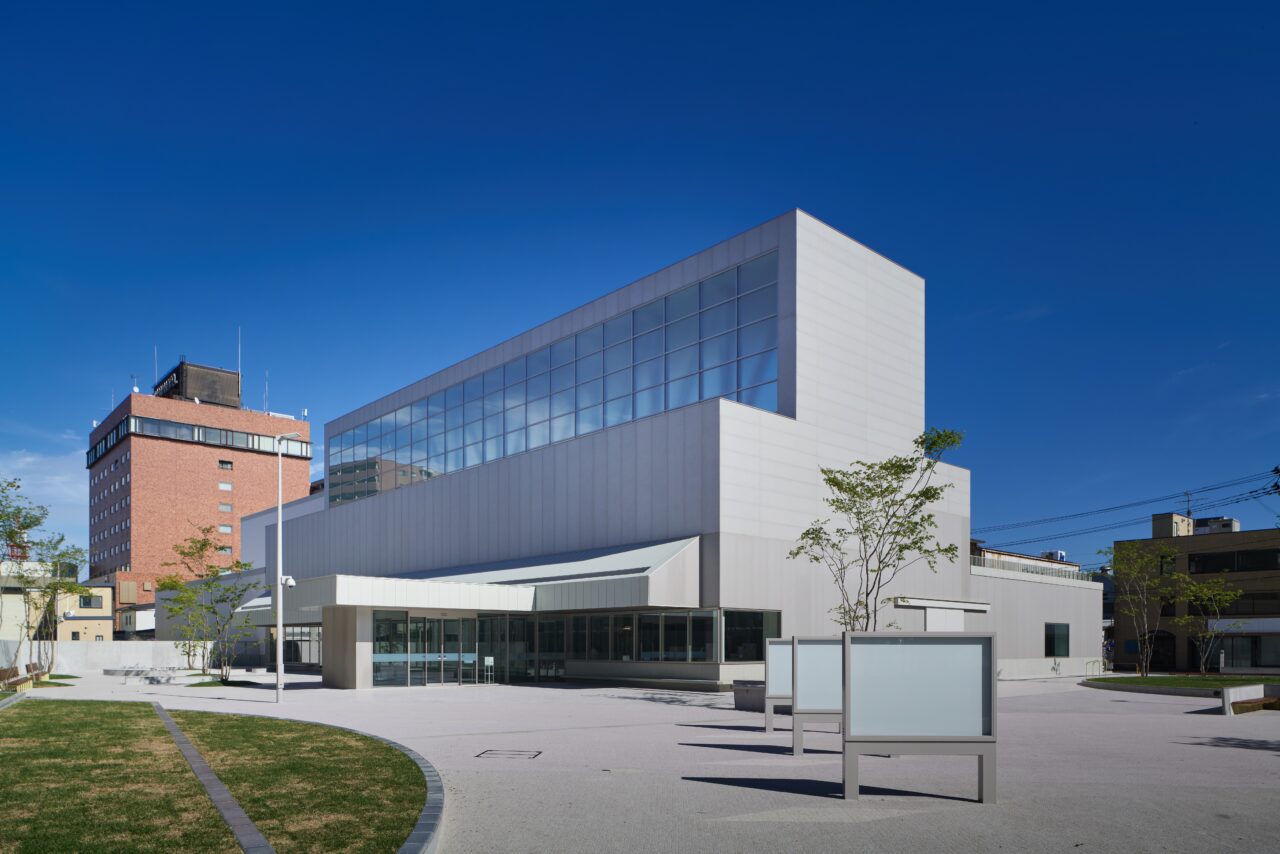
▲Hachinohe Art Museum
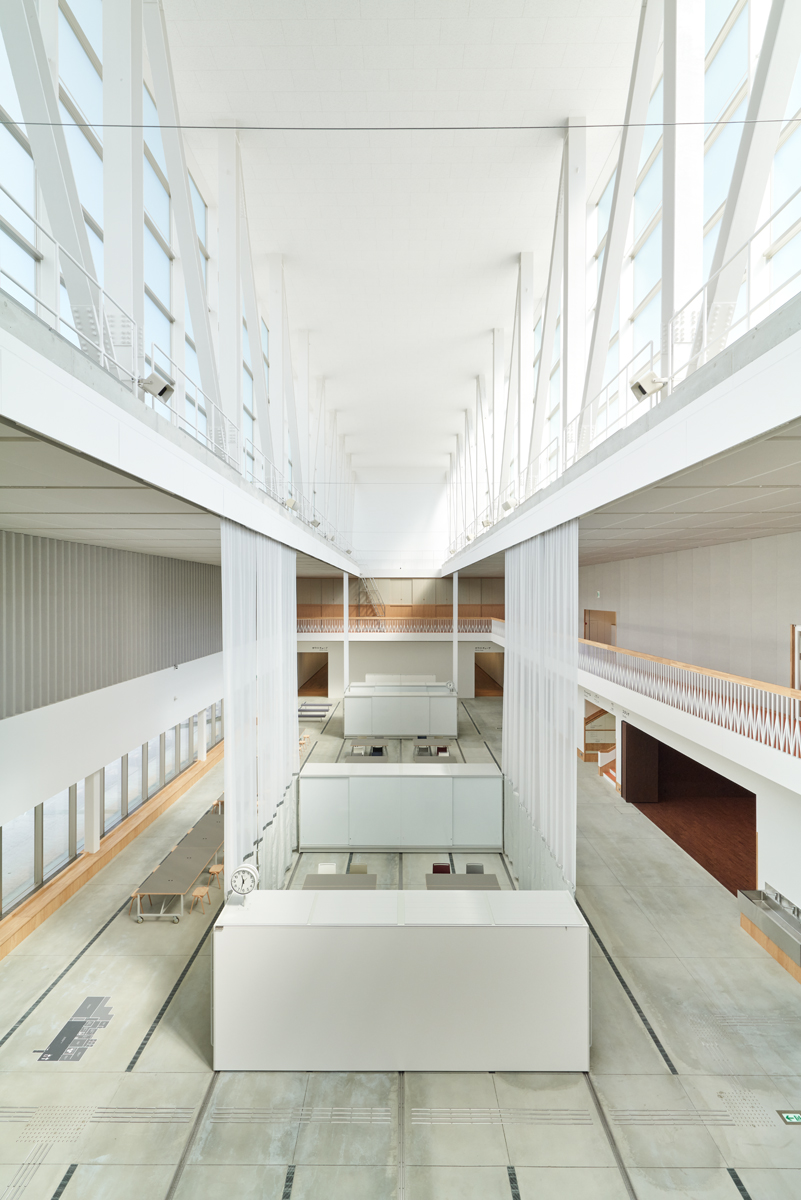
▲The Giant Room
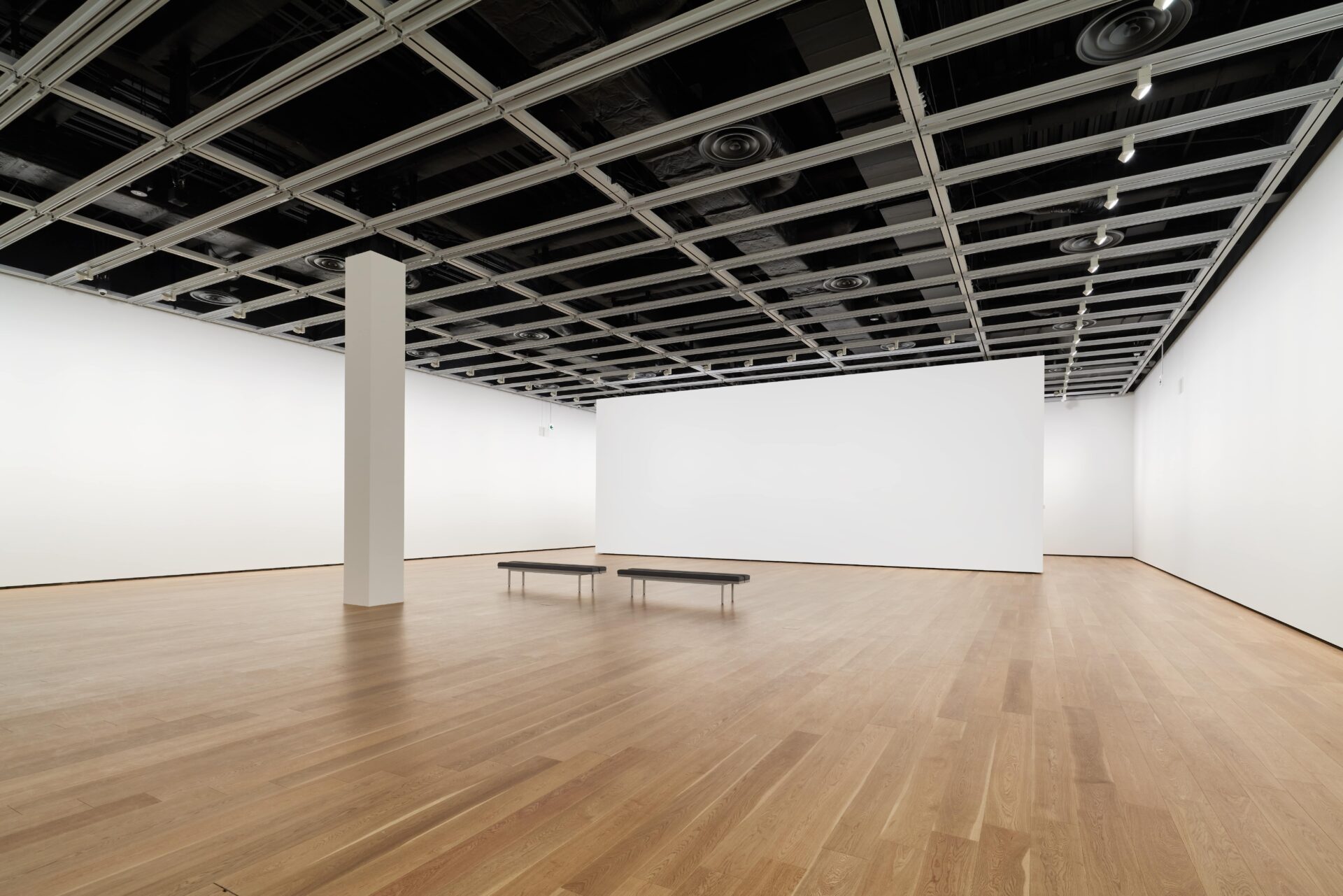
▲ Exhibition Rooms
The Museum as an Art Farm for Encounters and Learnings
Opened on November 3, 2021, the Hachinohe Art Museum was re-envisioned as an “art farm for encounters and learnings”, where personal growth leads to community development.
In addition to the space for exhibiting artworks as objects, the Giant Room, a large space for people to engage in activities, is a distinctive feature of the museum. People and objects encounter and learn from each other, and bring about new objects and experiences which nurture further creations. Aiming to be a soil for cultural creation in the community, the museum holds exhibitions that provide opportunities for everyone to casually experience art, and various projects that trigger encounters and learnings through art together with the public.
Hachinohe Art Museum
10-4 Oaza-Ban-cho, Hachinohe-shi, Aomori
Phone|+81 (0)178-45-8338
FAX|+81 (0)178-24-4531
Opening Hours| 10:00–19:00 (Last admission by 18:30)
Closed on Tuesdays (or the following day if Tuesday is a national holiday),
Year-end and New Year holidays.
https://hachinohe-art-museum.jp/visitor-en/
Hachinohe Book Center
Hachinohe Book Center – The Hub for Living with Books
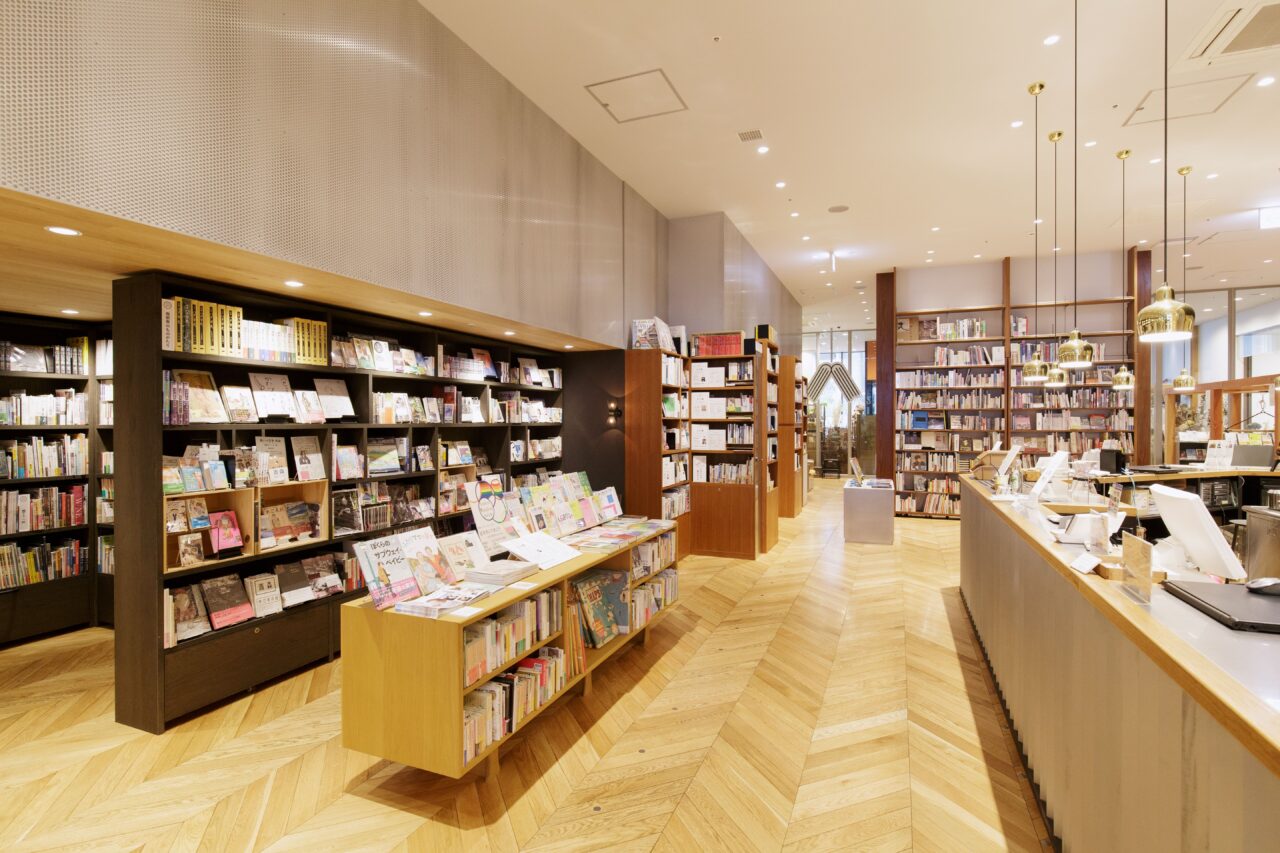
▲Inside the Center
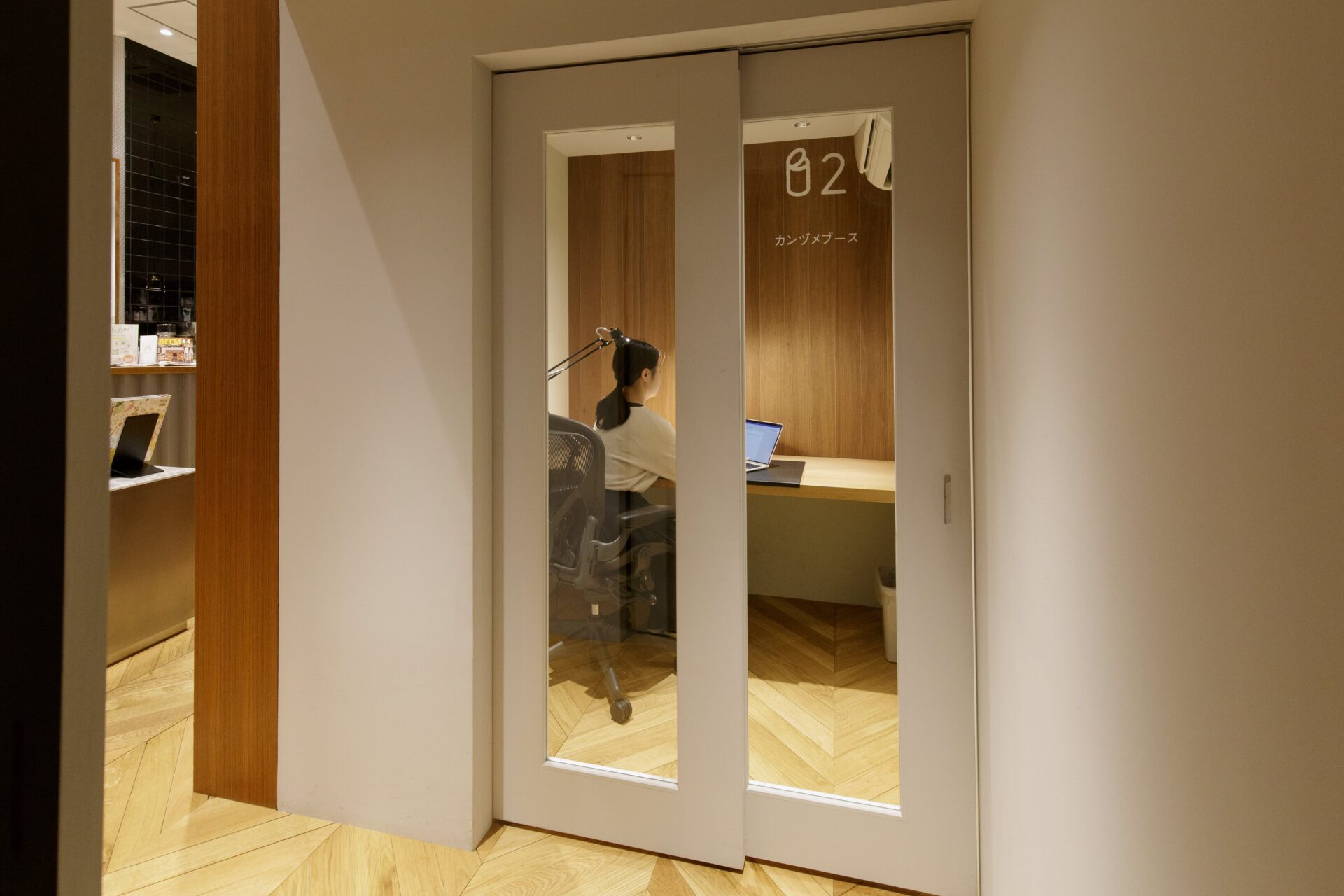
▲ Kanzume (confined) Booth
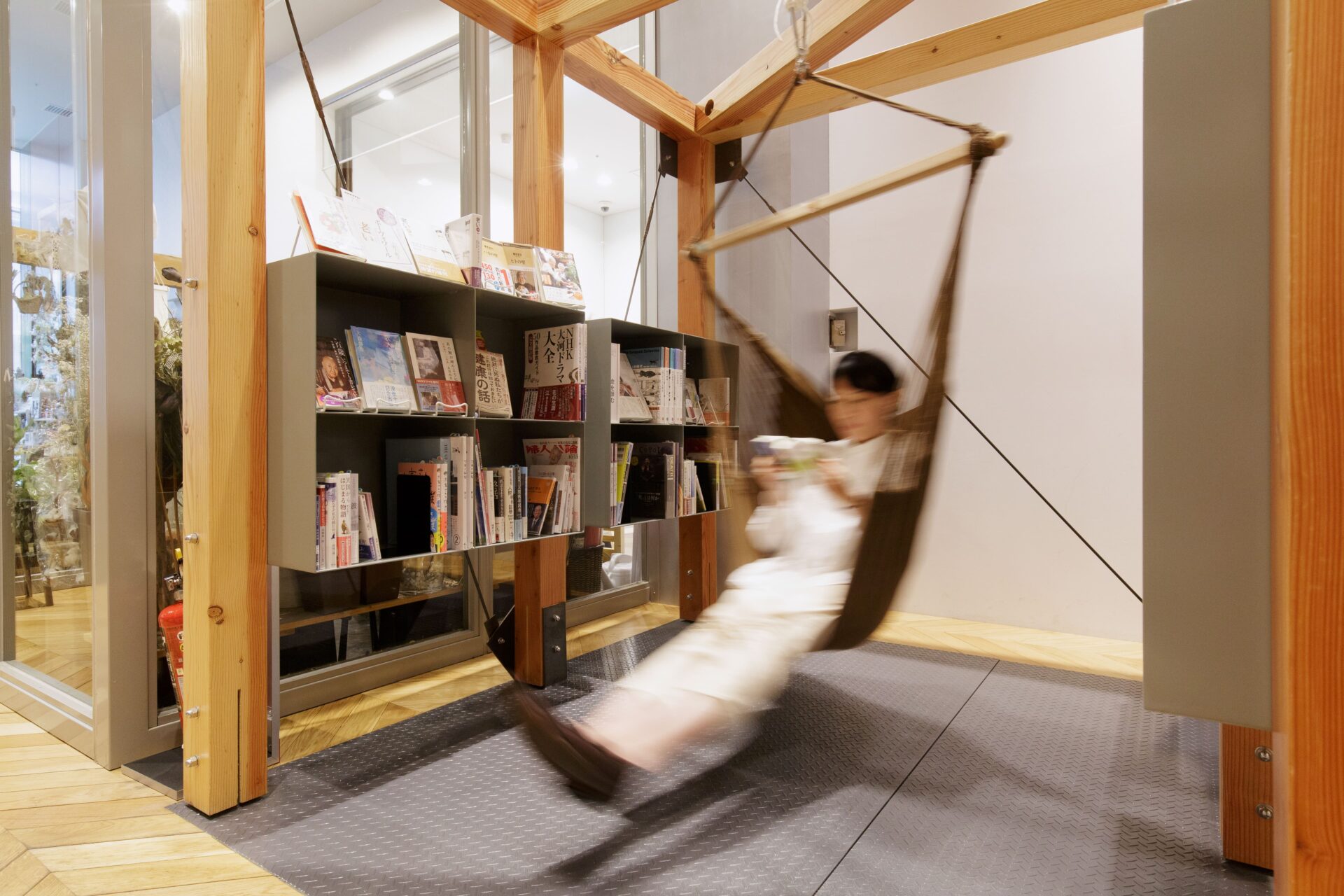
▲ Hammock Seats
An Extraordinary Type of Bookstore
This is a bookstore operated by the City, which is rare to come across in Japan. The bookshelves are arranged by theme to create the chance for visitors to encounter new books. You can browse at your leisure on sofas and hammocks while sipping hand-drip coffee and other beverages available for purchase inside the building. In addition, the “Kanzume (confined) booths” have been set up exclusively for writing. At the bookstore, assistance and workshops are also available to assist those in the process of getting their work published.
Hachinohe Book Center
Aomori, Hachinohe, Muikamachi, 16-2 Garden Terrace 1
Phone|+81 (0)178-20-8368
Phone|+81 (0)178-20-8218
Mail| bookcenter@city.hachinohe.aomori.jp
Opening Hours| 10:00–20:00 (Sun and National holidays|10:00–19:00)
Closed on Tuesdays
Hachinohe Portal Museum “Hacchi” / Hachinohe Machinaka Plaza “Machiniwa”
Energizing the Town, Energizing People
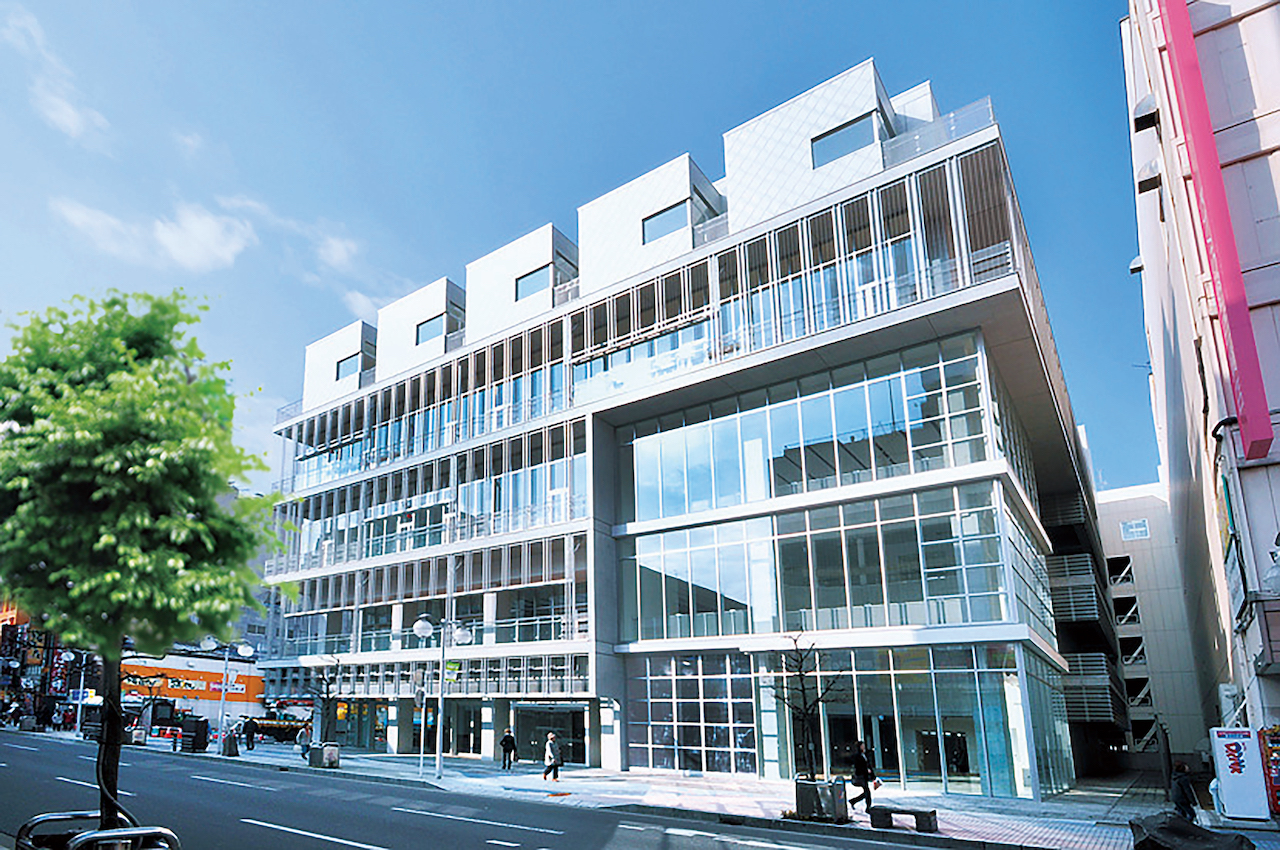
▲Hachinohe Portal Museum Hacchi’s Glass-walled Exterior
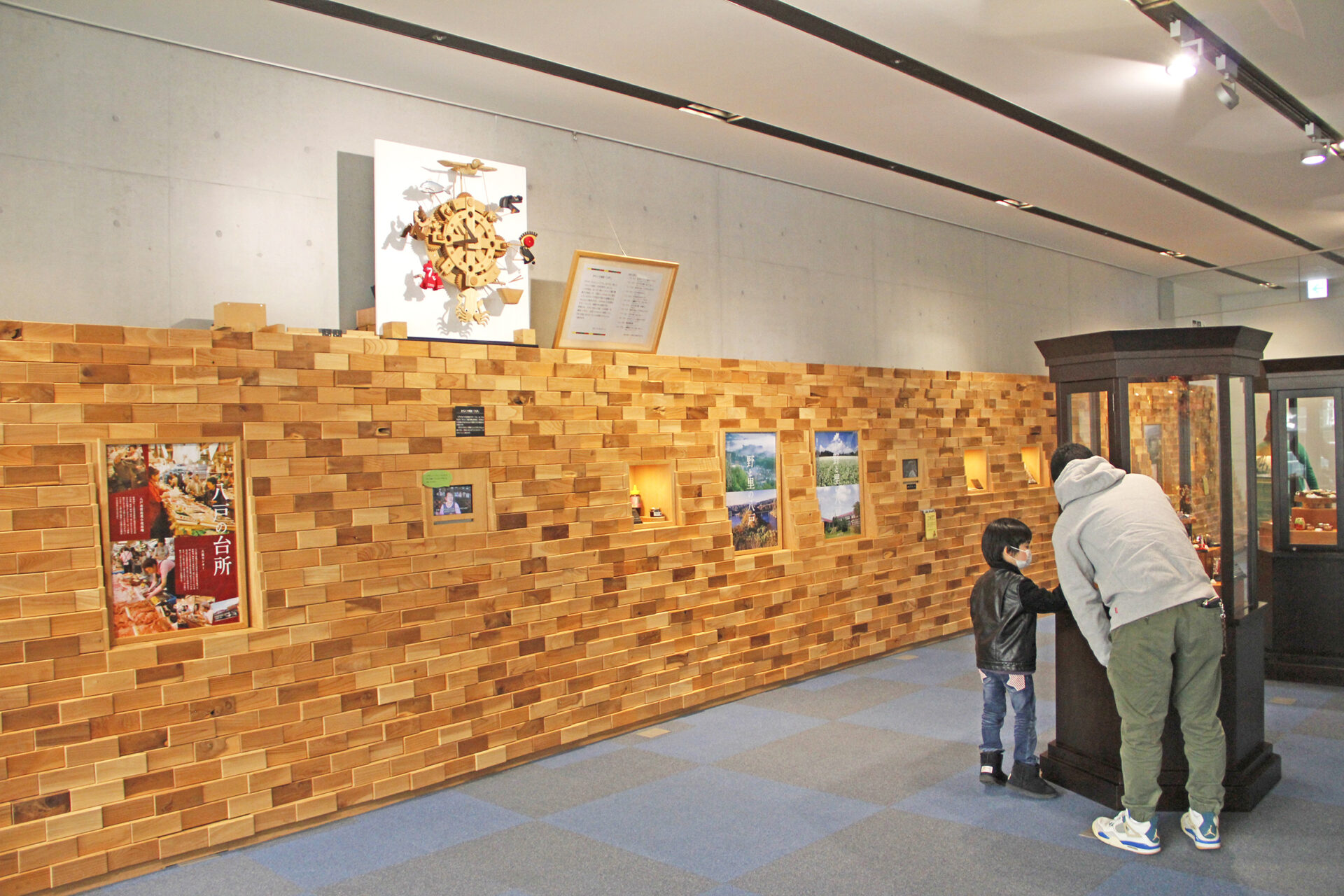
▲Hachinohe Portal Museum Hacchi’s In-house Facilities
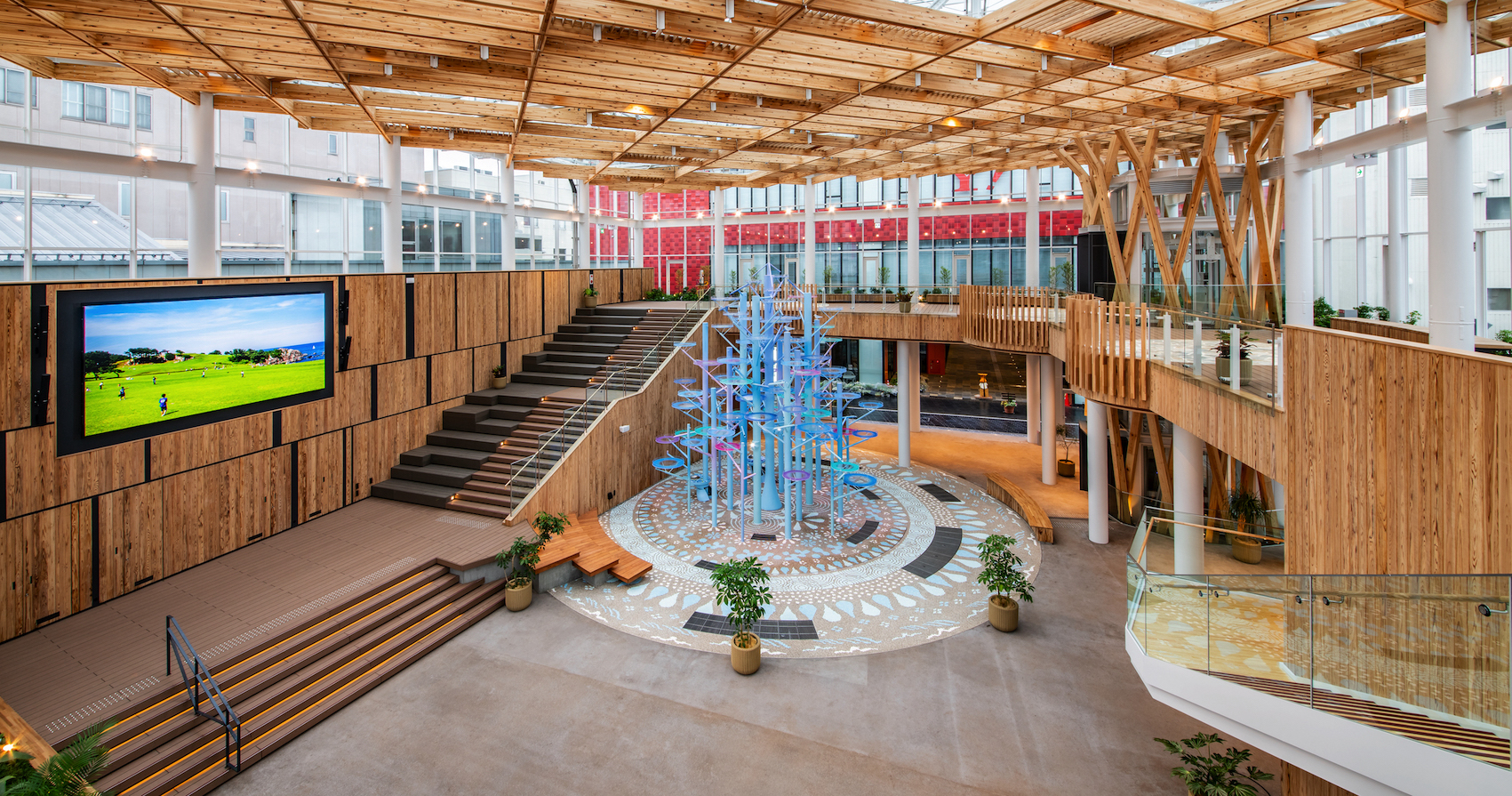
▲A Stylish Plaza, “Machiniwa”
Introducing Hachinohe’s Charms and Sightseeing Spots
This cultural and tourist exchange facility introduces Hachinohe’s local charms and attractions, including nature, food, festivals, history, and culture. It serves as a portal that leads visitors to various tourist attractions. Based on the concept of “creating new charms while respecting Hachinohe’s assets,” the museum has a system that brews the civic pride of the Hachinohe locals. Across the street from the museum, is Machiniwa, a glass-walled plaza. In addition to its daily use as a meeting place and resting area, it can also be used as a multipurpose space for events.
Hachinohe Portal Museum “Hacchi”
11-1 Mikkamachi, Hachinohe, Aomori
Phone|+81 (0)178-22-8228
Opening Hours |9:00-21:00
*Closed on the second Tuesday of each month.
Hachinohe Machinaka Plaza “Machiniwa”
21-1 Mikkamachi, Hachinohe, Aomori
Phone|+81 (0)178-22-8228(Hacchi)
Opening Hours |6:00-23:00
Hachinohe Yokocho
A Nostalgic Space with an Atmosphere from the Showa Era
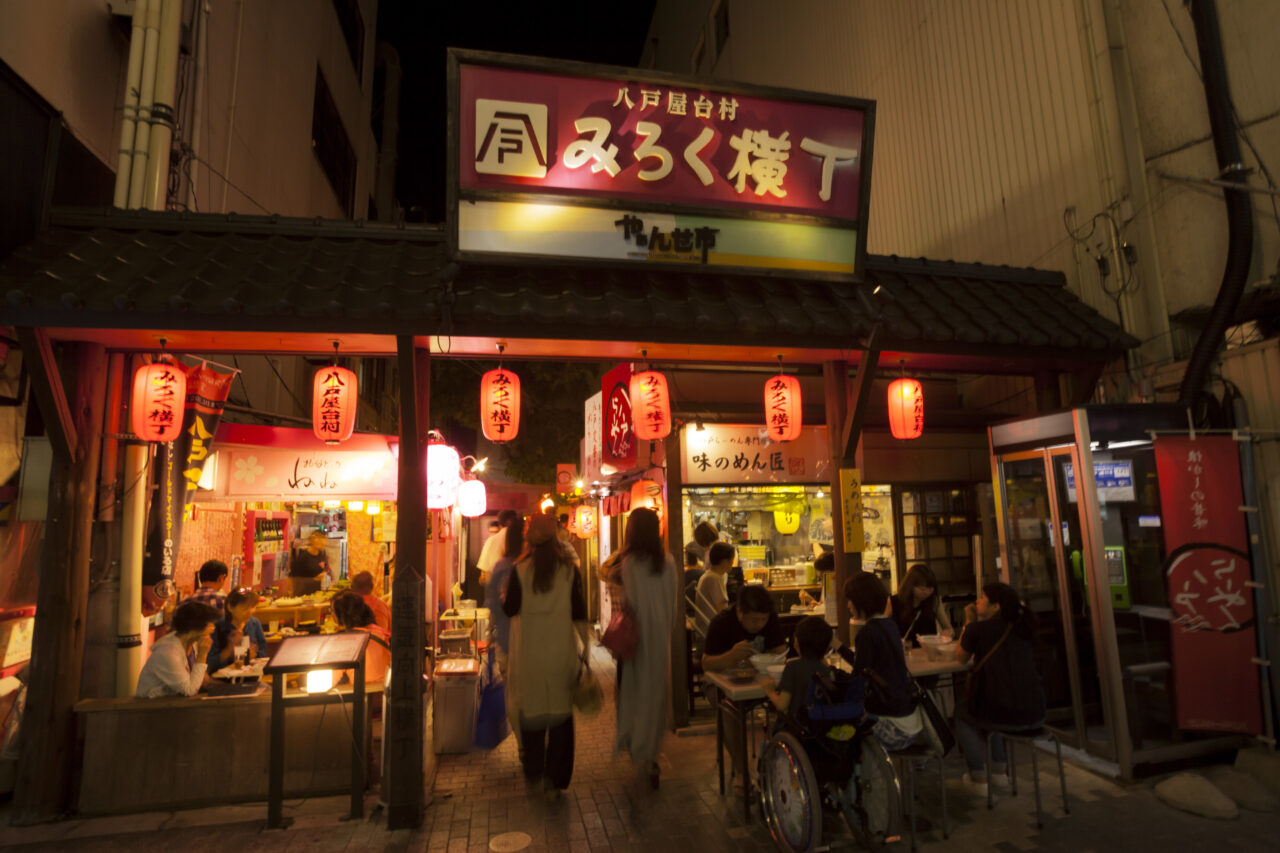
▲ Miroku Yokocho
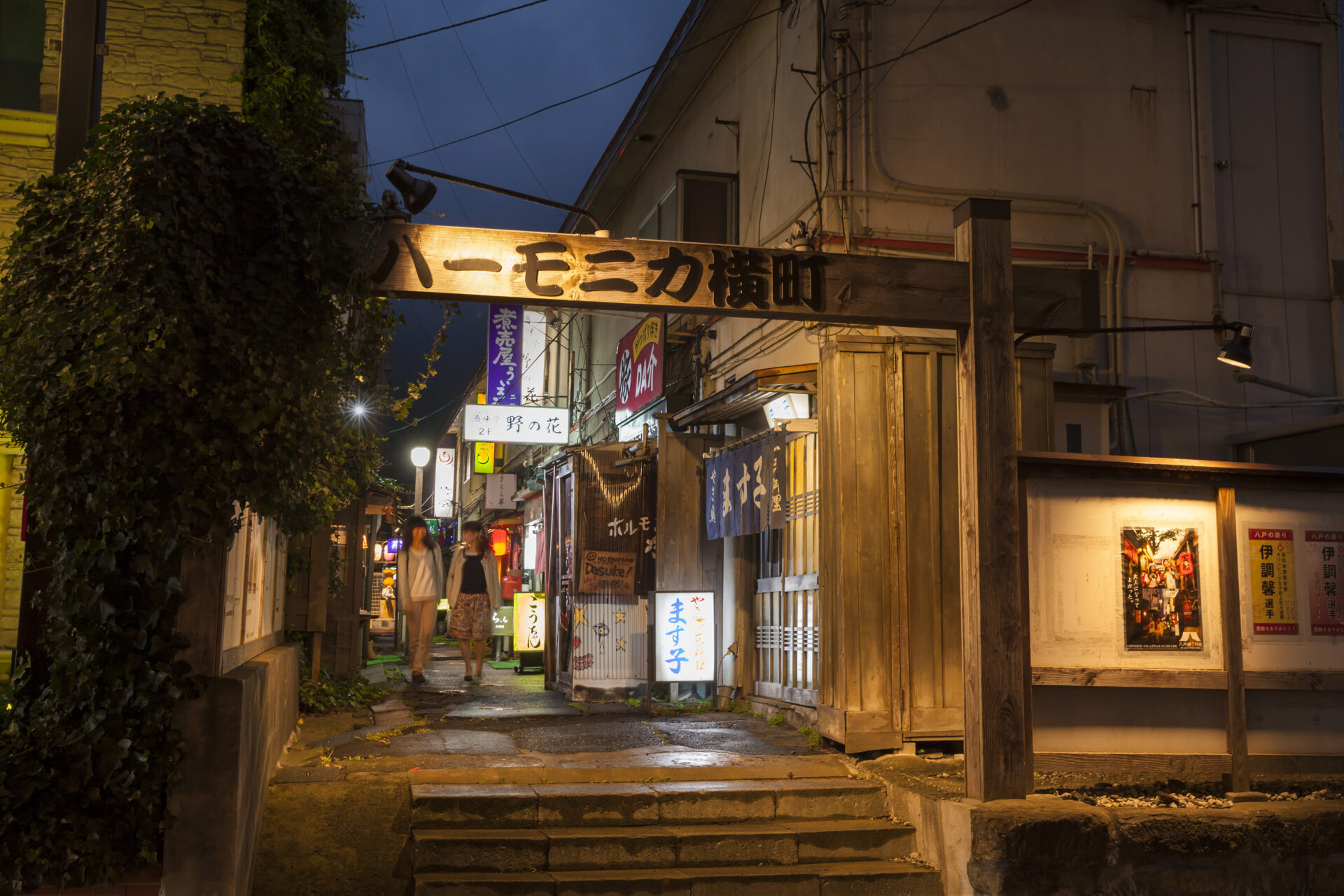
▲ Harmonica Yokocho
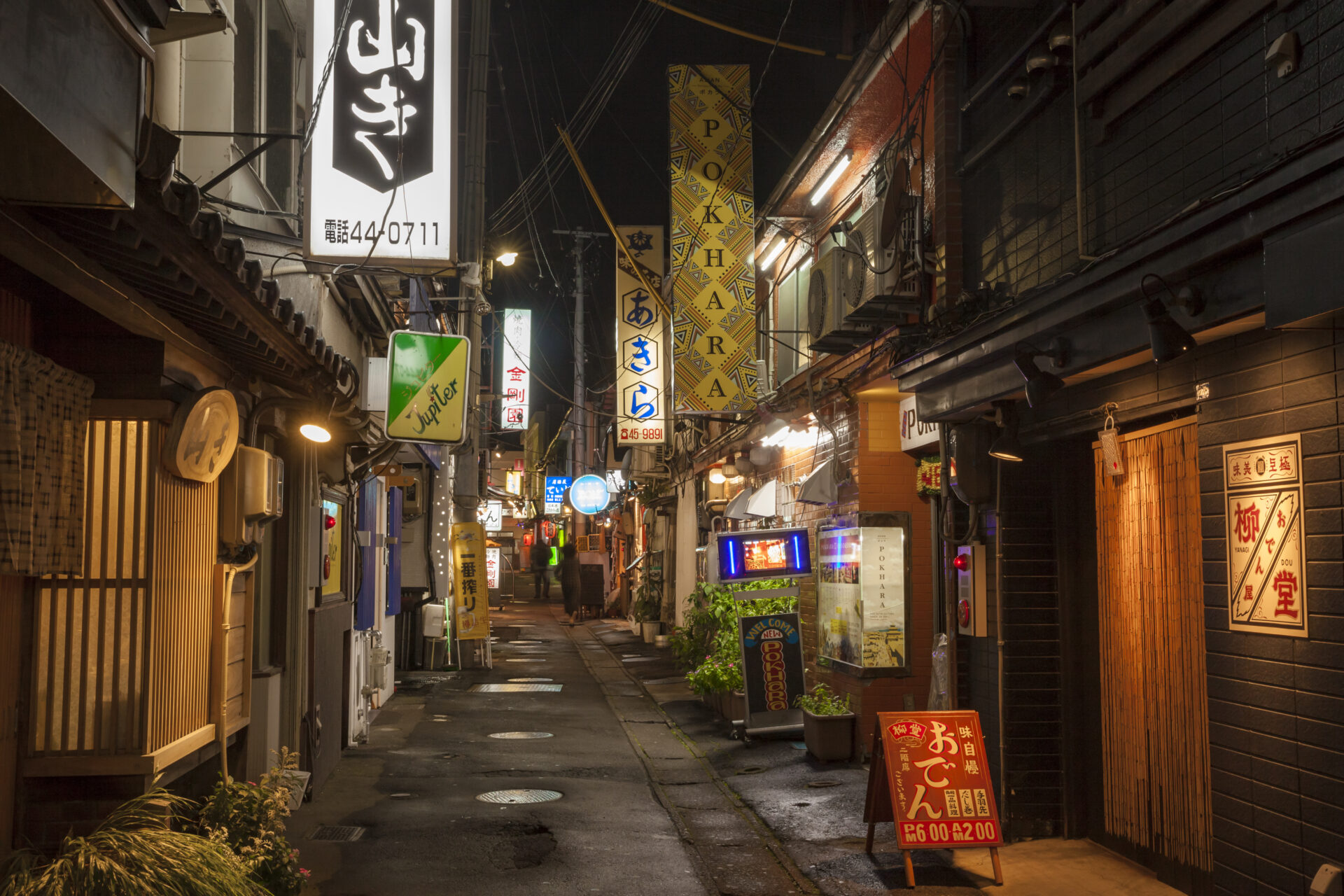
▲ Nagayokocho Rensa-gai
Forget about Time and Enjoy the Tasty Sake and People’s Kindness.
In Hachinohe, there are still eight yokocho (alleyways) remaining, lined with famous restaurants loved by the locals. They are bustling every night with people seeking the atmosphere of the Showa period, good sake and food.
Each yokocho has its own unique atmosphere, with a wide variety of stores, including izakaya (Japanese-style pubs) serving Hachinohe’s local cuisine, small restaurants where regular customers gather, long-established snack bars, and ethnic restaurants. One of the charms of yokocho is the close proximity to shopkeepers and neighboring customers, which makes it easy to become friends with those you meet for the first time.
Since hopping from one stall to another is the best part of the experience, we recommend visiting several stalls to enjoy a variety of tastes!
Hachinohe Yokocho (8 locations)
- Miroku Yokocho
- Tanuki Koji (Racoon Alley)
- Goban-gai (5th Street)
- Hachinohe Showa Dori
- Harmonica Yokocho
- Nagayokocho Rensa-gai
- Kuchiicho Rensa-gai
- Hana Koji (Flower Alley)
■Contact
NPO Iwate Arts Support Center
3F Morioka Odori Bldg. 15-7 1-chome Minami Odori, Morioka, Iwat e 020-0874
TEL|+81-19-656-8145
FAX|+81-19-656-8146
MAIL| sanfes@iwate-arts.jp
Areas
Artists
-
Nakano Fuji no Kai
Bon odori dances from the area once called Nukanobu, spread from the southern Aomori to northern Iwate region, are called “Nanya doyara” and have long been enjoyed as one of the few forms of entertainment among the people. It is said that there are hundreds of varieties of bon odori, with each region and village having their own unique characteristics and variations.
In today’s world of diversifying entertainment, opportunities to enjoy the Nanya doyara with the participation of the people are decreasing, and the number of skilled performers are aging. Nakano Fuji no Kai, a preservation society founded by local volunteers in 2014, is working to enhance the appeal of its hometown by promoting the Nanya doyara, which is unique to the Nakano area of Hirono Town, to the next generation, and by expanding its activities into a wide range of PR and exchange fields. -
Ono Naru Ikazuchi Taiko
Ono Naru Ikazuchi Taiko was formed in 2000 by a group of young men and women who took a taiko drumming course. Today, the group has 28 members ranging in age from 5 to 46 years old.
The name, “Ono Naru Ikazuchi Daiko”, comes from Naru Ikazuchi Shrine, the town deity of Ono, in Hirono Town (formerly Ono Village). It is hoped that the taiko drumming will develop to become something that represents the former Ono Village, and be loved by the villagers as a prayer for a good harvest and family safety.
Trained in musical composition and performance by Warabi-za, a renowned troupe based in Akita Prefecture, the group is named after the image of lightning, and their drum music is valiant and charged with youthful passion and freshness. -
Kadono Hama Komaodori Preservation Society
During the Warring States period, the Nanbu Hachinohe Clan ruled the area from southern Aomori to northern Iwate. The Koma Odori dance is said to be a dance that depicts the scene of going into battle, and cavalry battles at that time. It is also said that the dance was performed to comfort the spirits of horses and ancestors who died in battle, as well as to ensure the safety of the horses, which always supported the people as war and farm horses.
Since 1978, the dance has also been performed by children at local elementary and junior high school athletic meets and cultural festivals to pass on the geinoh and to promote their physical fitness and growth.
There are 14 types of dances: 7 dances performed with horse-like costumes, and 7 stick dances performed with poles, swords, and long swords. -
Iwate Prefecture Iwaizumi High School’s Geinoh Club
Since its establishment in 1990, the club has performed at nine national competitions, three times at the National Theatre of Japan, and once in Paris. Many of the members not only belong to the club, but they are also a group of volunteers who aspire to pass on the Nakano Nanazumai dance. Although it is difficult to balance their activities during the peak season, they feel the need in spreading the local folk dance to as many people as possible, and to pass it on to younger generations.
It is said that the Nakano Nanazumai was created around the time of the “Seven Years of Famine” in the Tempo era based on the “Shittogi-jishi-mai” of the Kuromori Kagura from Miyako City. With the dancers divided into seven roles, and seven different dances comprise the whole, it is said that this is where Nanazumai (literally, seven dances) got its name. The dancers play the role of farmers who cultivate the fields, plant crops, protect them from vermin, and share the harvest, all in the hope of a bountiful gathering. -
Iwate Prefecture Kitakami Shonan High School’s Onikenbai Club
Onikenbai is a geinoh handed down by farmers in the Kitakami region of Iwate Prefecture, and is said to have begun approximately 1,300 years ago.
Under the guidance of Iwasaki Onikenbai, a Nationally-Designated Important Intangible Folk Cultural Property, the club of 50 members participated in the National High School Culture Festival held in Tokyo in August 2021, representing Iwate Prefecture.
They perform a brave and dynamic sword dance called “Katana Kenbai no Kurui”, a four-sided formation dance called “Hitori Kago”, and “Sanban-niwa no Kurui” which is rich in variety in both dance and music, among others.
Sanriku International Arts Festival 2022 REVIVE
– An FY 2022 Japan Cultural Expo Project Presented and Co-presented by Japan Arts Council and Agency for Cultural Affairs, Government of Japan

Organized by|Sanriku International Arts Committee, Japan Arts Council, and Agency for Cultural Affairs, Government of Japan
Co-organized by|Hachinohe City, Hashikami Town, Hirono Town, Kuji City, Noda Village, Fudai Village, Tanohata Village, Iwaizumi Town, Miyako City, Yamada Town, Otsuchi Town, Kamaishi City, Ofunato City, Rikuzentakata City, Sumita Town, Sanriku Railway Co., Ltd., Japan Folk Performing Arts Association, NPO Iwate Arts Support Center, and NPO Japan Contemporary Dance Network
Cooperated by|NPO Shinsai Regain, imajimu LLC, Tohoku Cultural Property Video Research Institute, Minna no Shirushi LLC
